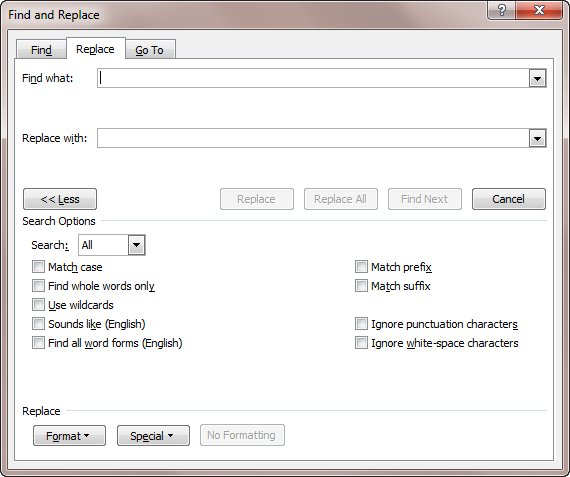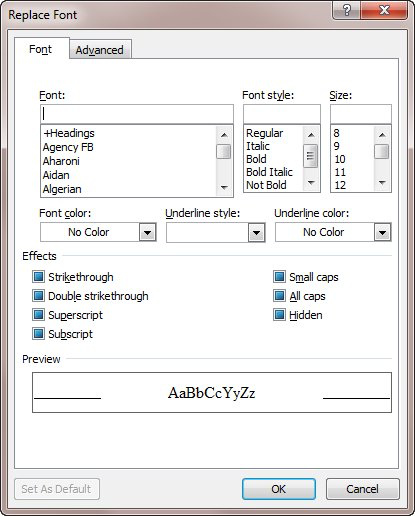Please Note: This article is written for users of the following Microsoft Word versions: 2007, 2010, 2013, 2016, 2019, 2021, 2024, and Word in Microsoft 365. If you are using an earlier version (Word 2003 or earlier), this tip may not work for you. For a version of this tip written specifically for earlier versions of Word, click here: Formatting All Headings At Once.
Written by Allen Wyatt (last updated May 17, 2025)
This tip applies to Word 2007, 2010, 2013, 2016, 2019, 2021, 2024, and Word in Microsoft 365
Suppose you want to apply a particular formatting attribute to all the headings in your document in one fell swoop. If you use four heading levels in your document, and you want to make them all red, you could use Find and Replace to search for all the heading levels, in turn, and change them to red. This gets tedious, of course. You could speed up the process by using a macro, but the macro would still be quite long since you would still need to do four separate Find and Replace operations.
There is a quicker way, however: Do your work in Outline view. When you show only certain heading levels in Outline view, Find and Replace only operates on those particular heading levels. Follow these steps:

Figure 1. The Replace tab of the Find and Replace dialog box.

Figure 2. The Replace Font dialog box.
The result of this procedure is that all the headings in the document are changed to red text. This works because Find and Replace only works with whatever is visible when you are working in Outline view. If you didn't use Find and Replace, but instead selected the whole document (Ctrl+A) and changed the font to red, Word would make the changes in everything you see and everything that is hidden. Using Find and Replace, instead, results in only the visible text being modified.
There is one time when you may not want to use this approach—if your document uses headers and footers, and especially if you have differing headers and footers for multiple sections in your document. The reason is because for some reason, Find and Replace changes the headers and footers to red as well, even though they are not visible in Outline view. (Why? I have no idea; it shouldn't work that way!)
If you want to bypass this problem, then you need to take a few additional steps by modifying the style definitions for your headings. Display the Styles task pane by pressing Alt+Ctrl+Shift+S. In the task pane, hover the mouse pointer over a heading style, click the down-arrow to the right of the style name, and then choose Modify. In the resulting dialog box, change the font color to red and click on OK. Repeat these steps for each of the heading styles you use.
While not technically fitting the definition of changing the formatting "all at once," you'll end up with the heading formatting you want and no other text (such as headers or footers) will be affected.
WordTips is your source for cost-effective Microsoft Word training. (Microsoft Word is the most popular word processing software in the world.) This tip (5969) applies to Microsoft Word 2007, 2010, 2013, 2016, 2019, 2021, 2024, and Word in Microsoft 365. You can find a version of this tip for the older menu interface of Word here: Formatting All Headings At Once.

The First and Last Word on Word! Bestselling For Dummies author Dan Gookin puts his usual fun and friendly candor back to work to show you how to navigate Word 2019. Spend more time working and less time trying to figure it all out! Check out Word 2019 For Dummies today!
When settling on an overall design for your document, you need to decide how you want your headings to appear. If you ...
Discover MoreIf your heading styles are designed to add extra space before the heading, you may be surprised when that extra space is ...
Discover MoreWord provides a few ways you can adjust pagination to accommodate where you want your headings to appear. If you want ...
Discover MoreFREE SERVICE: Get tips like this every week in WordTips, a free productivity newsletter. Enter your address and click "Subscribe."
There are currently no comments for this tip. (Be the first to leave your comment—just use the simple form above!)
Got a version of Word that uses the ribbon interface (Word 2007 or later)? This site is for you! If you use an earlier version of Word, visit our WordTips site focusing on the menu interface.
Visit the WordTips channel on YouTube
FREE SERVICE: Get tips like this every week in WordTips, a free productivity newsletter. Enter your address and click "Subscribe."
Copyright © 2025 Sharon Parq Associates, Inc.
Comments